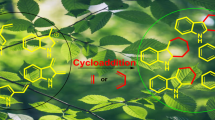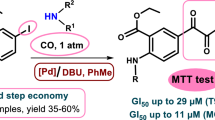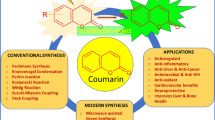Abstract
We have designed and synthesized a new fluorescent receptor 3 utilizing biquinoline as a molecular scaffold. The receptor 3 has two amide hydrogens and two carbamate hydrogens anchored at 4,4′-position of biquinoline. Fluorescence and 1H NMR titration showed that receptor 3 bound anions with different stoichiometry depending on the shape of anions and its association constants for anions reflected the basicities of anions. Receptor 3 bound chloride, acetate and benzoate in 1:2 stoichiometry and had a highest affinity for acetate. Tetrahedral shaped dihydrogen phosphate bound receptor 3 in 1:1 stoichiometry, although its affinity was low.
Graphical abstract










Similar content being viewed by others
Notes
Synthesis of compound 1: To a solution of di-tert-butyl dicarbonate (1.6 g, 7.49 mmol) in methanol (5 ml) was added ethylenediamine (500 mg, 8.3 mmol) at 0 °C. The solution was stirred for an hour and the solution temperature was raised to room temperature slowly. After the solution was stirred for 4 h more, the precipitated solid was removed through filtration. Evaporation of the liquid layer and silicagel chromatography of the residue with 50 % methanol in dichloromethane gave the compound 1 (1.54 g) in 88 % yields. 1H NMR (CDCl3, 500 MHz): 5.37(s, 1H), 3.26(s, 2H), 3.03(m, 2H), 2.64 (t, J = 6.0, 2H), 1.30 (s, 9H). Synthesis of compound 3: The suspension of 2,2′-biquinoline-4,4′-dicarboxylic acid(150 mg, 0.44 mmol) in thionyl chloride (10 ml) was refluxed for 5 h. After all of starting material was dissolved, the reflux was stopped and all of thionyl chloride was evaporated in vacuo to give compound 2. The remained material was directly used for next reaction without purification. The remained material was dissolved in dried DMF (10 ml). Then the compound 1 (209 mg, 1.31 mmol) in dried pyridine (8 ml) was added to this solution in ice bath and the solution temperature was raised to room temperature slowly. Then the reaction mixture was stirred for 2 h. Filtration of precipitated solid gave the desired compound 3 (105 mg) in 38 % yields. 1H NMR (DMSO-d6, 500 MHz) 8.98(t, J = 5.5, 2H), 8.82(s, 2H), 8.27(d, J = 8.0, 2H), 8.22(d, J = 8.0, 2H), 7.91(t, J = 8.0, 2H), 7.73(t, J = 8.0, 2H), 6.97(t, J = 5.5, 2H), 3.45(m, 4H), 3.25(m, 4H), 1.40(s, 18H) 13C NMR(500 MHz, DMSO-d6) 166.81, 155.75, 154.41, 147.53, 143.79, 130.47, 129.67, 128.12, 125.74, 124.56, 116.19, 77.68, 28.26 two peaks are hidden in DMSO solvent peak. LRMS m/z (M+): calcd, 628.30, found, 628.35.
In the NMR titration and fluorescence titration, solution of anion was added to the solution of host. The volume change of host solution was less than 4 % during titration and dilution effect was ignored. In the NMR titrations the mole ratio was measured by integration values between host 3 and tetrabutylammonium anion salts.
References
Haugland, R.P.: The Handbook A Guide to Fluorescent Probes and Labeling Technologies, 10th edn. Molecular Probes Inc, Eugene (2005)
Stibor, I. (ed.): Anion Sensing. Springer-Verlag, Berlin (2005)
Lhoták, P.: Anion receptors based on calixarenes. Top. Curr. Chem. 255, 65–95 (2005)
Matthews, S.E., Beer, P.D.: Calixarene-based anion receptors. Supramol. Chem. 17, 411–435 (2005)
Martinez-Manez, R., Sancenon, F.: Fluorogenic and chromogenic chemosensors and reagents for anions. Chem. Rev. 103, 4419–4476 (2003)
Beer, P.D., Gale, P.A.: Anion recognition and sensing: the state of the art and future perspectives. Angew. Chem. Int. Ed. 40, 486–516 (2001)
Haryley, J.H., James, T.D., Ward, C.J.: Synthetic receptors. J. Chem. Soc., Parkin Trans. 1(19), 3155–3184 (2000)
de Silva, A.P., Nimal Gunaratne, H.Q., Gunnlaugsson, T., Huxley, A.J.M., McCoy, C.P., Rademacher, J.T., Rice, T.E.: Signaling recognition events with fluorescent sensors and switches. Chem. Rev. 97, 1515–1566 (1997)
Czarnik, A.W. (ed.): Fluorescent Chemosensors for Ion and Molecule Recognition. American Chemical Society Books, Washington, DC, (1993)
Gale, P.A.: Anion receptor chemistry: highlights from 1999. Coord. Chem. Rev. 213, 79–128 (2001)
Gale, P.A.: Anion coordination and anion-directed assembly: highlights from 1997 and 1998. Coord. Chem. Rev. 199, 181–233 (2000)
Keefe, M.H., Benkstein, K.D., Hupp, J.T.: Luminescent sensor molecules based on coordinated metals: a review of recent developments. Coord. Chem. Rev. 205, 201–228 (2000)
Czarnik, A.W.: Chemical communication in water using fluorescent chemosensors. Acc. Chem. Res. 27, 302–308 (1994)
Fabbrizzi, L., Poggi, A.: Sensors and switches from supramolecular chemistry. Chem. Soc. Rev. 24, 197–202 (1995)
Kwon, J.Y., Jang, Y.J., Kim, S.K., Lee, K.-H., Kim, J.S., Yoon, J.: Unique hydrogen bonds between 9-anthracenyl hydrogen and anions. Org. Chem. 69, 5155–5157 (2004)
Kim, S.K., Singh, N.J., Kim, S.J., Kim, H.G., Kim, J.K., Lee, J.W., Kim, K.S., Yoon, J.: New fluorescent photoinduced electron transfer chemosensor for the recognition of H2PO4 −. Org. Lett. 5, 2083–2086 (2003)
Liu, Y., Song, Y., Chen, Y., Li, X.-Q., Ding, F., Zhong, R.-Q.: Biquinolino-modified β-cyclodextrin dimers and their metal complexes as efficient fluorescent sensors for the molecular recognition of steroids. Chem. Eur. J. 10, 3685–3696 (2004)
Job, P.: Formation and stability of inorganic complexes in solution. Ann. Chim. 9, 113–203 (1928)
Benesi, H., Hildebrand, H.J.: A spectrophotometric investigation of the interaction of iodine with aromatic hydrocarbons. Am. Chem. Soc. 71, 2703–2707 (1949)
Hynes, M.J.: EQNMR: a computer program for the calculation of stability constants from nuclear magnetic resonance chemical shift data. J. Chem. Soc., Dalton Trans. 311–312 (1993)
Vyacheslav, S., Bryantsev, V.S., Diallo, M.S., Duin, A.C.T., Goddard III, W.A.: Evaluation of B3LYP, X3LYP, and M06-class density functionals for predicting the binding energies of neutral, protonated, and deprotonated water clusters. J. Chem. Theory Comput. 5, 1016–1026 (2009)
Acknowledgments
This research was supported by Basic Science Research Program through the National Research Foundation of Korea (NRF) funded by the Ministry of Education, Science and Technology (2010-0021333).
Author information
Authors and Affiliations
Corresponding authors
Rights and permissions
About this article
Cite this article
Kim, YH., Moon, J., Kang, J. et al. A new anion receptor with biquinoline molecular scaffold. J Incl Phenom Macrocycl Chem 76, 119–124 (2013). https://doi.org/10.1007/s10847-012-0180-2
Received:
Accepted:
Published:
Issue Date:
DOI: https://doi.org/10.1007/s10847-012-0180-2




